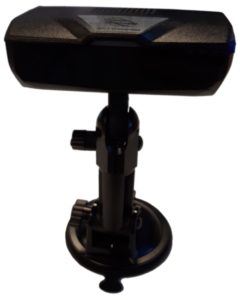Loss of attention detector: safety first

The loss of attention detector is a cutting-edge Driver Monitoring System (DMS), meticulously crafted to enhance road safety. Employing a secure suction cup attachment to the dashboard, this innovative device serves as a proactive solution for maintaining driver attentiveness. Its advanced features not only prevent drowsiness but also actively prompt the driver to focus on the road, issuing timely warnings in the face of potential danger should their attention waver during the journey.
An astonishing high-tech device
Equipped with an integrated camera, our system goes beyond conventional monitoring by scanning the driver’s face and analyzing real-time behavior. Whether the driver wears glasses, sunglasses, or navigates through total darkness, our advanced technology remains unfazed.
A sophisticated loudspeaker intervenes decisively when signs of drowsiness emerge, if the driver’s gaze diverts from the road, or if facial orientation shifts sideways—effectively curbing distractions such as smartphone usage. Furthermore, the system detects and promptly addresses the use of a cigarette, ensuring a comprehensive approach to driver safety.
Why should you get it?
1/ To prevent the risk of accidents related to drowsy driving.
For optimal bodily rejuvenation, adults typically need between 7 and 9 hours of sleep each night. Despite this, a concerning 32% of drivers admit to experiencing sleep deprivation, with an alarming 12% disclosing that they have either come dangerously close to or directly caused an accident due to drowsiness-induced impairment in their driving performance.
2/ To prevent the risk of accidents linked to loss of attention.
A tool for fleet management
Beyond serving as a driver-alert buzzer, the attention loss detector not only caters to the driver’s needs but also holds significant value for fleet managers due to its inherent connectivity features.
By establishing a seamless connection with a geolocation tracker, such as the Type XX (e.g., Type 2 CLASSIC), the device integrates with GPS technology, discerning whether the vehicle is in motion or stationary. This capability enables the system to adapt its functionality based on these distinct scenarios. The inclusion of a micro-USB port with versatile multi-cables facilitates the connection of additional devices, ranging from LED warning lights to diverse peripherals, like a video recorder for capturing crucial footage.
All events flagged by the attention loss detector are meticulously logged and easily accessible through the Platinum platform, providing a comprehensive overview of the driver’s engagement and potential instances of drowsiness.
(Source of statistics: “Trajets professionnels sur autoroute” ASFA-APR Nov 2017).
In addition, the conclusion of the study on drowsiness while driving published by the Vinci Autoroutes Foundation on December 21, 2021: https://fondation.vinci-autoroutes.com/fr/system/files/pdf/2021/12/2021-12-21_cp_fondation_vinci_autoroutes_etude_somnolence.pdf
Contact us for more information about our products.